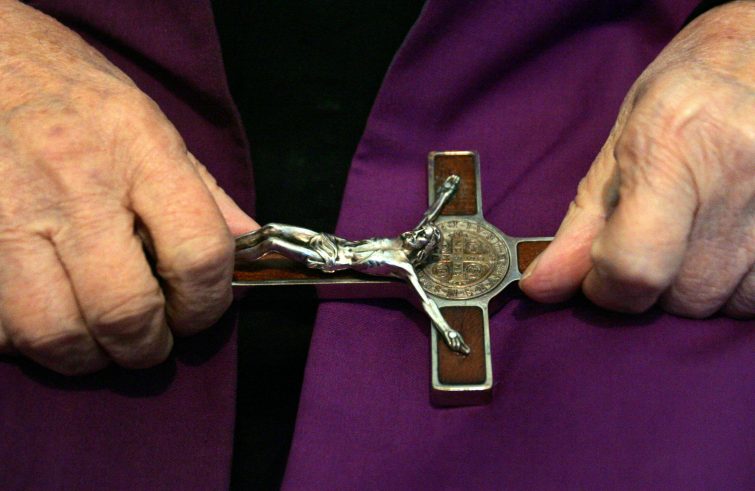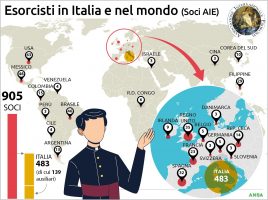
The number of exorcist priests in Italy and throughout the world is growing. In fact, the number of members of the International Association of Exorcists (IEA), the only body officially recognised by the Holy See, is on the increase: in just ten years, the number of members has almost quadrupled, from 250 in 2012 to 905 today. Europe is the continent with the largest number of members (70%), with Italy in first place (483 members, including 139 auxiliaries); followed by North America (13%), with the United States (62) and Mexico (48); South America (11%), led by Brazil (46); and Asia (6%, including 3 in China and 2 in Taiwan). Africa remains under-represented with 13 members. The many projects carried out with a view to formation include a course on the fundamental aspects of the ministry of exorcism in Italy, Spain, Hungary, Ukraine, South Korea, Thailand, Brazil, Mexico and Argentina. “Exorcists are the witnesses, the voice and the ambassadors of Christ and the Church to those who are suffering because of the evil one. Their task and duty is to proclaim to their brothers and sisters afflicted by the devil that that they are particularly dear to the Heart of Jesus, his Mother and the entire Church,” said Father Francesco Bamonte, who has headed the IEA since 2012 and is now its vice-president, speaking at the XIV International Convention of the IEA during which his successor was elected: Msgr. Karel Orlita, exorcist and canonist from the Czech Republic, consecrated in the Secular Institute Servants of Suffering and external theologian of the Dicastery of the Causes of Saints.

You were born into a Christian family and grew up under the Communist regime. You worked as a blacksmith when it was impossible to enter the seminary. The secret police spied on you because of your faith in Christ. Was this a turning point in your calling to the ministry?
Christians were responsible citizens and hard workers. They contributed to the well-being of the Czech Republic and to its moral standing. But communism could not tolerate that. Our neighbours were on the payroll of the communist regime, they spied on us and reported everything they saw. And above all, they made up stories: we discovered this when we finally had access to the archives in the 1990s. It was then that I felt the calling of the Lord. While the Communist Party officials hated the Church in the Czech Republic, God loved the people: in my family alone, there were five vocations to the consecrated life.
From a small town in the Czech Republic to Rome, where you were called to lead the association that represents exorcists throughout the world.
From 2012 to the present day, under the presidency of Father Francesco Bamonte, the IEA has better defined its objectives and perfected the instruments for achieving them. Its growth in numbers and in esteem within the Church is undoubtedly attributable to this.
I will therefore continue to pursue the same path, ensuring continuity of content and method, with the intention of improving what can be improved, not arbitrarily but in a style of true synodality.

How did you become an exorcist?
I was formally trained in canon law, so I assisted the bishop in these matters. One day, while I was in the curia, the bishop opened the door of his office and went out in a deep state of agitation. He had had an encounter with a person who was possessed and he was very upset, and so was the secretary who was with him. On that occasion he asked me to become an exorcist and gave me the mandate. That was nearly fifteen years ago.
The IEA has grown in its recognition inside the Church and now has members in 58 countries around the world. Nevertheless, in some dioceses it is still difficult to find an exorcist to turn to…
The reasons for this difficulty vary from diocese to diocese and it is not possible to list them all. I should however point out that
some Bishops complain that they do not have priests in their clergy who are qualified to carry out the ministry of exorcist, and are more than ever anxious to rely on one or more exorcists to carry out the pastoral care of deliverance from the extra-ordinary workings of the Evil One.
They say that it is not enough to have a good theological preparation and to be a good priest to be an exorcist: something else is needed! And I totally agree.
Who are the people who turn to exorcists?
There are women and men of faith who are subjected to an action that God allows, sometimes in an extraordinary way, by the evil one. But there are also people who turn to us as if we were the good magicians, the Catholic magicians. They don’t know exactly what an exorcist is: a priest who carries out Christ’s ministry, authorised by the bishop.
First of all, the exorcist helps the person in his or her journey of faith, to improve the quality of his or her Christian life.
And through exorcism, he helps them in their struggle against the extraordinary affliction of the evil one. Some people believe that the exorcist will help them to get rid of this evil affliction without a spiritual path. But it doesn’t work that way. It cannot be cured with pills.
Is there an appeal you would like to make?
I would like to make an appeal, based on the speech given by Pope Paul VI at the Mariological and Marian Congress on May 16, 1975, to everyone, especially to the young and the young at heart, to follow and to encourage them to follow that path which is accessible to everyone, even to simple souls: the path of beauty. And to do this, we must turn our gaze to Mary, contemplate her immaculate beauty and, at the same time, direct our gaze to our brothers and sisters who, because they are saints, reflect the infinite beauty of the Incarnate Word, the most beautiful of all children of men, Jesus. Unfortunately, when our eyes are too often offended by this world’s deceptive images of beauty, they are also blinded.











